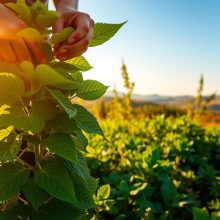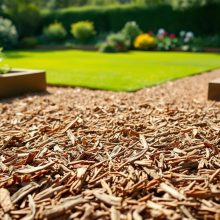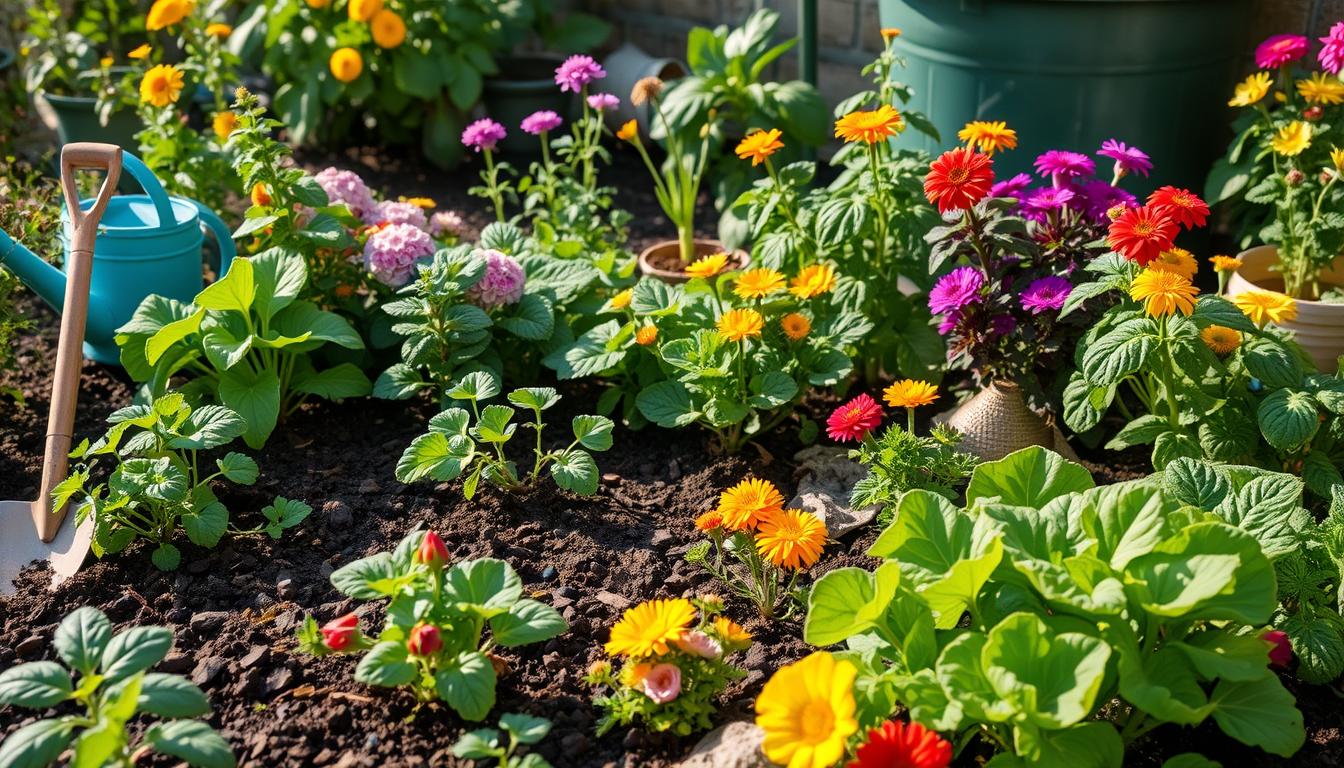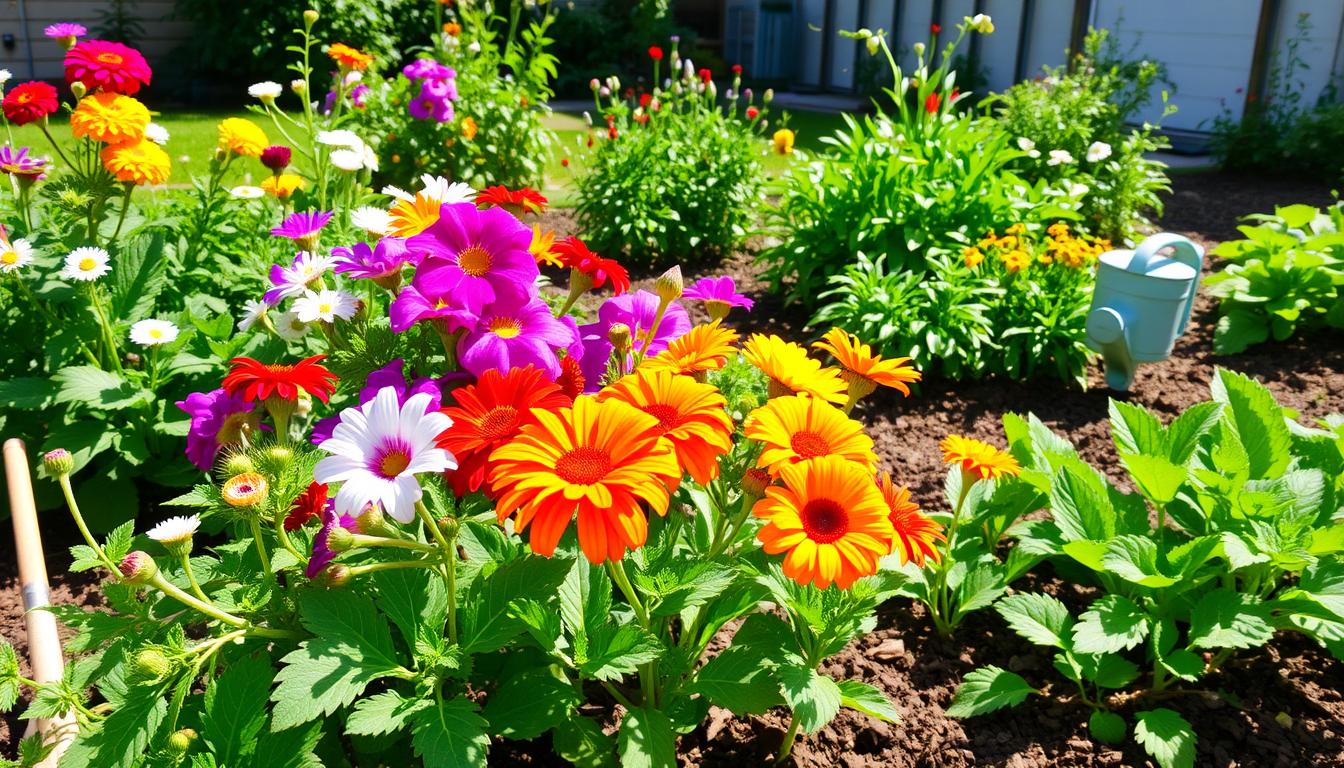Cultivate a Sustainable Garden: Tips and Tricks
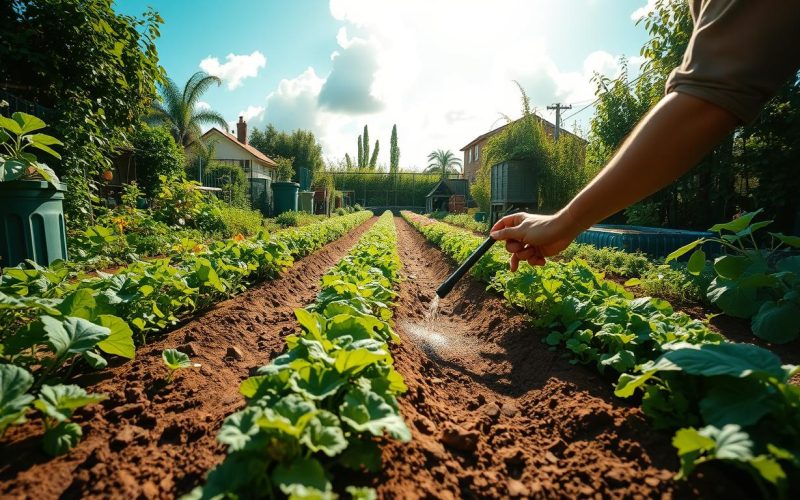
Sustainable gardening is changing how Americans landscape. People across the U.S. are finding eco-friendly tips to protect our planet and make beautiful gardens. These methods focus on saving resources, managing them well, and keeping ecosystems healthy.
Today’s sustainable gardening is about making choices that are good for the environment. Gardeners use smart techniques to make landscapes that help local wildlife, save water, and use fewer chemicals. This approach links personal gardening to caring for the planet.
Getting into sustainable gardening means seeing how our gardens connect with nature. Every choice we make, from picking plants to managing soil, helps create a garden that works well with the environment.
Key Takeaways
- Sustainable gardening protects local ecosystems
- Reduce chemical use in garden maintenance
- Support local wildlife through mindful landscaping
- Conserve water with strategic gardening techniques
- Create a resilient and productive garden environment
Understanding Sustainable Gardening Practices
Sustainable gardening is about growing green spaces that live in harmony with nature. It uses organic gardening methods to create beautiful, productive gardens that help our planet. This way, gardeners can make a positive impact while enjoying their work.
This approach focuses on reducing harm to the environment and keeping natural ecosystems intact. It’s more than just gardening; it’s about finding balance and saving resources.
Definition of Sustainable Gardening
Sustainable gardening is a way to grow plants that:
- Uses fewer chemicals
- Conserves water and energy
- Helps local wildlife
- Improves soil health naturally
Benefits of Sustainable Gardening
Those who garden sustainably gain many benefits:
- Less harm to the environment
- Better soil health
- Lower costs for upkeep
- More support for local ecosystems
Key Principles of Sustainability
Good sustainable gardening follows key principles. It involves using native plants, saving water, avoiding harmful chemicals, and creating homes for local wildlife. By doing this, gardeners can create gardens that are good for both people and the planet.
Choosing Native Plants for Your Garden
Green gardening starts with native plants. These local heroes are perfect for eco-friendly gardens. They make your garden a thriving ecosystem.
Native plants are a smart choice for gardens. They fit local conditions well, making them strong and easy to care for.
Advantages of Native Flora
- Need less water than other plants
- Resist local pests and diseases well
- Offer homes for local wildlife
- Save money on garden upkeep
- Help keep local species diverse
How to Select the Right Plants
Choosing native plants means knowing your climate and local ecosystem. Think about these when picking plants for your garden:
- Check your soil type
- Look up native plants in your area
- Consider how much sun and water they need
- Ask experts at local gardens or extension offices
Resources for Native Plant Selection
Good sources can guide you to the right native plants. Look at local nurseries, botanical sites, and gardening groups. Your local extension office is also a great place for advice.
Soil Health: The Foundation of Sustainability
Healthy soil is key to successful sustainable landscaping. Gardeners who focus on earth-friendly practices know soil quality affects plant growth and garden health. It’s all about the soil.
To have rich, nutrient-dense soil, you need a plan. Healthy gardens start with the soil. They focus on creating the best environment for roots and microorganisms.
Understanding Soil Quality
Soil quality is what makes a garden thrive. Good soil has:
- Proper nutrient balance
- Good drainage
- Enough organic matter
- Balanced pH levels
Organic Matter and Composting
Composting is vital for earth-friendly gardening. It turns kitchen and garden waste into:
- Soil that’s full of nutrients
- Soil that’s better for plants
- Soil that holds water better
Soil Testing Essentials
Soil testing is crucial for garden health. It shows what your soil needs. With the right tools, you can fix any issues and keep your garden healthy.
Water Conservation Techniques
Sustainable gardening starts with smart water management. Using natural garden care strategies can cut down water use while keeping your garden healthy. Saving water is key for eco-friendly landscaping that protects our water.
Gardeners can make a big difference by using water-saving techniques. The trick is to use water wisely and avoid wasting it.
Efficient Watering Methods
- Install drip irrigation systems that deliver water directly to plant roots
- Use soaker hoses to minimize evaporation
- Water early morning or late evening to reduce water loss
- Group plants with similar water requirements together
Rainwater Harvesting
Collecting rainwater is a great way to avoid using city water. Simple rain barrel systems can catch thousands of gallons a year. This helps your garden and saves money on water bills.
Mulching Benefits
- Reduces soil moisture evaporation
- Regulates soil temperature
- Prevents weed growth
- Adds nutrients to soil as organic mulches decompose
By using these natural garden care strategies, gardeners can make sustainable landscapes. These landscapes save water and help local ecosystems.
Pest Management in a Sustainable Garden
Effective pest management is key in organic gardening. It keeps your garden healthy and thriving. Sustainable gardening means controlling pests without harming the environment.
Integrated Pest Management (IPM)
Integrated Pest Management (IPM) is a smart way to handle pests. It aims for long-term solutions and uses minimal intervention. This method combines different strategies to manage pests well.
- Identify pest problems early
- Monitor garden conditions regularly
- Use least-toxic control methods first
- Implement preventative measures
Beneficial Insects in Natural Pest Control
Some insects are your garden’s friends, fighting off pests. Ladybugs, lacewings, and wasps are great at controlling pests. They can greatly reduce the damage done by harmful insects.
- Attract beneficial insects by planting diverse flowers
- Create habitat areas for helpful insects
- Avoid broad-spectrum pesticides
Natural Pest Control Methods
Organic gardening has many ways to fight pests without chemicals. Physical barriers, companion planting, and natural repellents keep your garden safe. They help maintain the garden’s balance.
- Use row covers to protect plants
- Plant pest-deterrent herbs like basil and mint
- Create homemade organic pest sprays
- Implement crop rotation strategies
Creating Habitats for Wildlife
Turning your garden into a thriving ecosystem is key in environmentally friendly garden design. Wildlife habitats make your outdoor space beautiful. They also help support local biodiversity and keep the ecosystem balanced.
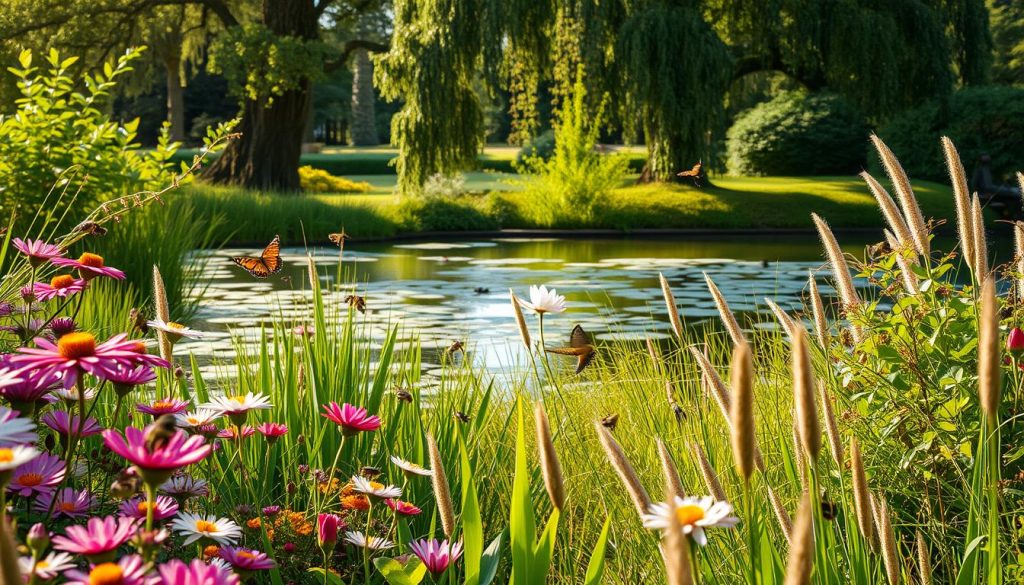
Green gardening ideas go beyond just picking plants. They involve creating welcoming spaces for local wildlife. By designing your garden to support different creatures, you can create a vibrant, natural environment.
Importance of Biodiversity
Biodiversity is the heart of a healthy garden ecosystem. A diverse habitat attracts many species. These species work together to keep the natural balance:
- Supports pollination processes
- Controls pest populations naturally
- Enhances overall garden resilience
Birdhouses and Bee Hotels
Putting birdhouses and bee hotels in your garden can make it a sanctuary for wildlife. These structures give safe nesting places. They help grow the numbers of important pollinators.
Pollinator-Friendly Practices
Pollinator gardens create a special bond between plants and insects. By choosing native flowering plants and keeping nectar sources steady, gardeners help bees and butterflies. This also boosts garden productivity.
- Plant diverse native flower species
- Avoid chemical pesticides
- Provide water sources for pollinators
Organic Gardening: Avoiding Chemicals
Organic gardening turns your garden into a thriving, chemical-free space. It uses natural methods to grow healthy plants and protect the environment.
Organic gardening is more than just avoiding chemicals. It’s a way to care for plants that works with nature. By using natural methods, gardeners can grow strong, healthy gardens.
Understanding Organic Inputs
Organic inputs are key to a successful garden without chemicals. They give plants the nutrients they need in a sustainable way:
- Compost made from kitchen and garden waste
- Organic fertilizers from natural sources
- Beneficial microorganisms that improve soil
- Natural amendments like bone meal and seaweed extract
Creating an Organic Garden Plan
Creating a detailed organic garden plan is important. It involves:
- Testing your soil to know its nutrient levels
- Picking plants that fit your local climate
- Rotating crops to keep the soil healthy
- Using companion planting to control pests
By using these organic gardening methods, you can make a beautiful, sustainable garden. Natural care not only helps the environment but also grows healthier plants.
Crop Rotation and Companion Planting
Sustainable landscaping is more than just gardening. Crop rotation and companion planting are key. They can make your garden more productive and healthy.
By understanding how plants work together, gardeners can boost their garden’s health. These methods help grow more food and fight pests.
Benefits of Crop Rotation
- Prevents soil nutrient depletion
- Reduces pest and disease cycles
- Improves overall soil structure
- Increases crop productivity
Successful Companion Planting Combinations
Some plants work better together. Here are a few examples:
- Tomatoes with basil: Repels pests and enhances flavor
- Corn, beans, and squash: Traditional Native American “Three Sisters” method
- Carrots with onions: Deters carrot fly
Planning Your Garden Layout
Planning is key for eco-friendly gardening. Think about plant families and how they grow. Also, consider how they keep pests away.
Draw out your garden plan. Rotate crops each season. This keeps the soil healthy and fights disease.
Vertical and Container Gardening Techniques
Urban gardeners and homeowners with little outdoor space can change their gardening with new methods. These eco-friendly tips help grow plants in small areas. They make the most of every green space.
Vertical gardening is great for small spaces. It uses walls, hanging structures, and tiered planters. This way, gardeners can have lush green areas without needing a lot of ground.
Ideal Plants for Vertical Gardens
- Herbs like basil, thyme, and mint
- Compact vegetables such as lettuce and spinach
- Trailing plants like ivy and succulents
- Lightweight flowering plants including petunias
Container Gardening Essentials
Good container gardening needs careful planning and the right plants. Pick containers with good drainage. Use quality potting soil. Choose plants that fit your environment.
Space-Saving Strategies
- Install hanging planters on balconies
- Use stackable garden boxes
- Implement window box gardens
- Create mobile plant stands with wheels
Green gardening ideas don’t need a lot of space. With creativity and the right plants, anyone can have a thriving garden in little space.
Community Involvement in Sustainable Practices
Sustainable gardening is more than just a hobby. It involves the whole community working together. This effort changes local areas and raises awareness about the environment.
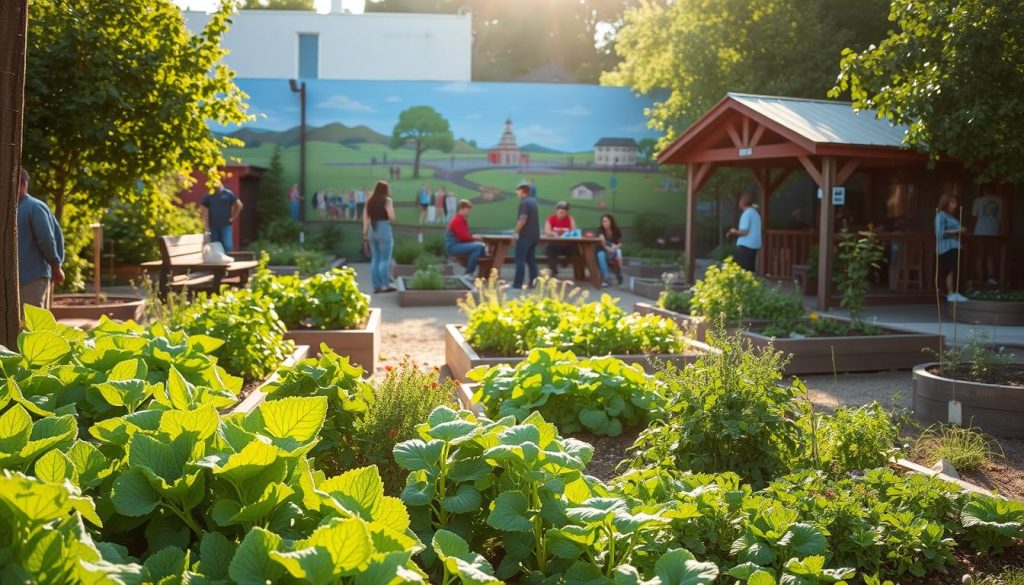
Working together with other gardeners can make a big difference. By sharing knowledge and resources, we can all do more for the planet.
Joining a Community Garden
Community gardens are great for learning and growing. They offer many benefits:
- Learn from experienced gardeners
- Share tools and resources
- Reduce individual carbon footprint
- Create local food networks
Local Workshops and Learning
Local gardening workshops are a great way to learn. They help gardeners improve their skills in eco-friendly gardening. Here’s what you can gain:
- Understand advanced sustainable techniques
- Network with local gardening enthusiasts
- Gain hands-on experience
Advocating for Green Practices
Every gardener can help make a difference. By supporting local green projects and using native plants, we can all help the environment. Sharing what we know is also important.
Continuous Learning and Improvement
Sustainable gardening is a journey of discovery and growth. It means always being curious and open to new ways to care for your garden. Every gardener can keep learning and find what works best for their garden.
To stay up-to-date with sustainable gardening, you need to keep learning. Read gardening magazines, go to workshops, and talk to other gardeners. Websites like the Sustainable Gardening Institute have great webinars and resources.
Trying new things is important in sustainable gardening. Start with small changes like using native plants or new ways to water. Keep a journal to note what works and what doesn’t. Every garden is different, so what works for one might not work for another.
Your gardening journey is about getting better and connecting with nature. By being open to new ideas and caring for the environment, you’ll make a beautiful garden. Enjoy the learning, and watch your garden become a vibrant, green space.
